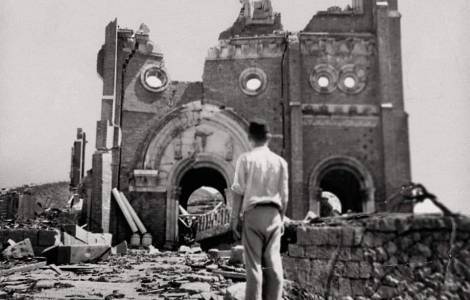
Vatican City (Agenzia Fides) - "The faithful of Nagasaki have had the strength to overcome many difficult difficulties throughout their history. They persevered first in the period of persecution and then, in the 20th century, when they were hit by the atomic bomb the same thing happened: even in the face of a tragic event, their faith saved them and they began to live and hope again. When we look back at our history, we find in our roots the hope that accompanies us," emphasizes Archbishop Peter Michiaki Nakamura of Nagasaki, an archdiocese in which there are 58,000 Catholics in an area of 1.2 million people.
Nagasaki is the symbolic city of Japanese Catholicism. It was the most important center of the Catholic community in Japan. In its history dating back to the 16th century, the community preserved the faith in silence for over two centuries during a time of severe persecution, with parents baptizing their children in secret despite not having access to the Eucharist due to a shortage of priests. A total of 26 Catholics were martyred in Nagasaki in 1597, and another 52 believers were martyred in this city in 1622. In recent history, the explosion of the atomic bomb on August 9, 1945 is also a wound that has left deep and indelible marks.
The Archbishop states: "This is the community of today: a community of faith that, after having experienced such tragic moments, bears witness to the hope of the risen Christ: precisely because we are facing death, persecution, death of the atomic bomb, and from these shocking events, we have risen again, there is hope in our hearts, yes, recovery, rebirth, thanks to the work of God".
"From the martyrs of Nagasaki we inherited the gift of faith," he continues. "Today the work of proclaiming the Gospel in our area is a little weak, because when you go out of the church, the witness of faith is also today in society, for various reasons, "a little weak and troublesome" compared to the people you meet. The bishop attributes this attitude to "the great period of persecution" when believers "had to protect and preserve themselves, because whoever showed their faith was arrested and even killed." Perhaps, he notes, "seeds of this attitude are still present today; there is a certain difficulty in publicly displaying and justifying one's faith. There is in people's DNA a sense of protection, an approach, in private, to stay in secret. But now we have to change and come out of our shell," he hopes.
"The topic we think about when we look to the future is precisely that of being an 'open-minded Church', he emphasizes. As a church, you shouldn’t stay in the sacristy, but you have to “be aware of the outside world. “We feel particularly challenged by the words and appeals of Pope Francis: We feel that these words of his apply precisely to us, precisely to Nagasaki. Our wish is: let us open ourselves to the outside world. “We should not only keep faith, the gift of Jesus Christ, as a treasure in our churches, but also see it as a precious gift for society and the world. This poses many questions and drives us forward,” he says.
In the Japanese context, the community of Nagasaki does not, as in other areas of Japan, have a large proportion of Catholic immigrants (although there are Filipino and Vietnamese Catholics in the area) who can also provide support for the life of faith. Although Nagasaki is a "peripheral city" in the Japanese archipelago, located far from the capital, it is the city most associated with and shaped by the history of Catholic missions. In these traces, in these roots, in this work of the Lord," Archbishop Nakamura concluded, "lies our life and our hope: today we walk together as a community so that it can flourish again". (PA) (Agenzia Fides, 24/4/2024)